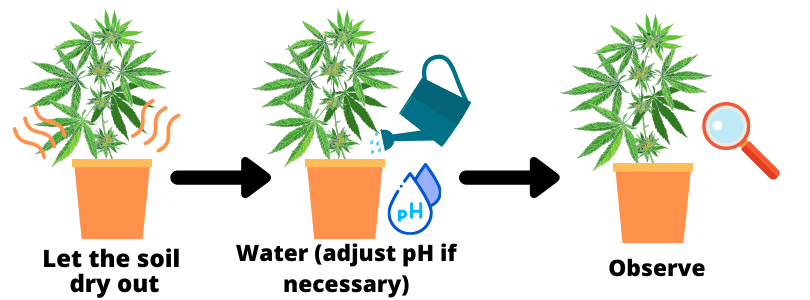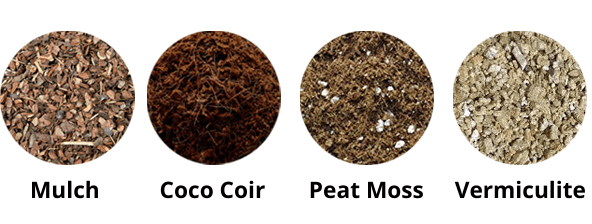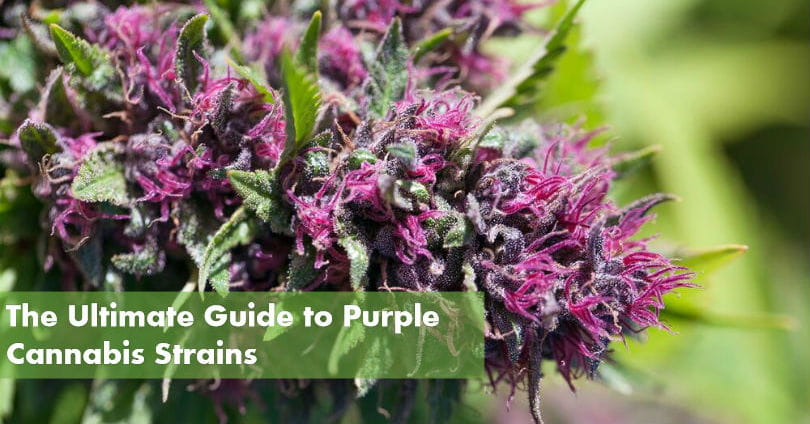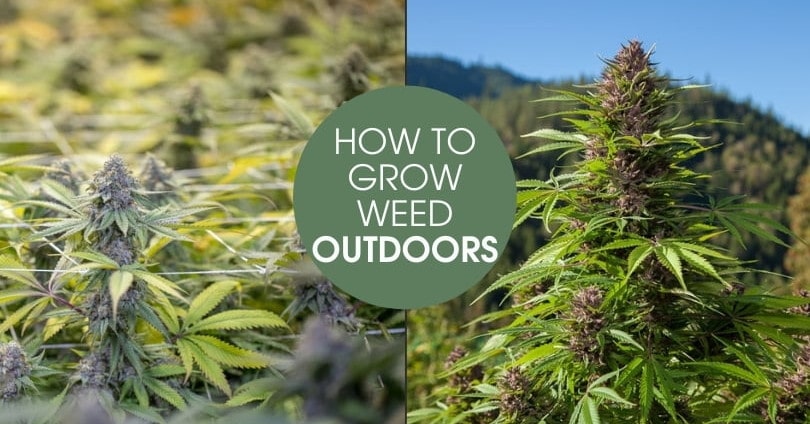 If you’re tired of over or underwatering cannabis plants — this is the guide for you.
If you’re tired of over or underwatering cannabis plants — this is the guide for you.
As you’ll soon learn, under and overwatering weed plants is incredibly common among cannabis cultivators. From beginners to stone-cold-professionals — everyone is liable to mess up the watering schedule at some point in their weed growing career.
Read along to discover our top tips and tricks to avoid irrigation problems. Once you’ve finished this tutorial and learned a few proper watering techniques — you’ll make growing top-shelf buds look easy.
Ready? Let’s go!
The Effects of Over and Under Watering Marijuana Plants
Before we show you how to stop over and underwatering weed plants — let’s take a look at what happens when you provide too little or too much water to your green beauties.
Let’s take a look at each in sufficient detail so you gain a clear understanding of what’s at stake.
The Cause and Effects of Overwatering Cannabis Plants
First, let’s take a look at the more common problem of the two.
New cannabis growers are obsessed with their crop’s health. Therefore, why do they drown their weed plants in water?
The answer to this is because they believe in giving a lot of a “good” thing. However, life will soon show you that too much of a good thing is actually bad. Ultimately, you’ll learn that extremes in either direction are likely to kill your weed crop — such as watering it too often.
Without further ado, here’s a list of common reasons for overwatered marijuana plants:
- Poor-draining medium
- Too-large container
- Watering at night or before “lights off”
- Watering too often
Therefore, here are the symptoms of overwatering your marijuana plants:
- Loss of oxygen intake/respiration
- Bacteria and fungal growth
- Weakened resistance to pests and disease
- Destroys the root system
- Stunts growth
- Provides an ideal environment for insect outbreaks
- Sudden death
As you can see, each of the issues mentioned above is catastrophic for your garden.

This is what can happen when your cannabis plant is overwatered.
The Cause and Effects of Underwatering Cannabis Plants
As we mentioned above, practicing extremes will only hurt your cannabis plants.
Therefore, you must take a moderate approach that avoids being too conservative with the water supply. In any case, here’s a list of common reasons for under-watered marijuana plants:
- Fast-draining medium
- Small container size
- Hot, dry, and windy environmental conditions
- Laziness/forgetfulness
If you allow your plants to dry out significantly — here’s a list of symptoms that you should expect to see:
- Wilted or fallen over plants
- Crispy or “burned” leaves
- Stunted growth
- Erratic pH fluctuations
- Salt buildup on the medium’s surface
- Sudden death
In other words, allowing the medium to go bone dry is not recommended. If you allow dry spells to occur in the garden — prepare an early grave for your cannabis plants.
Now that you understand the effects of both under and overwatering weed plants let’s look at how to avoid and fix these common irrigation mistakes.

Here’s a grow room with a lot of underwatered cannabis plants.
How to Fix an Overwatered Cannabis Plant in Four Steps
Let’s take a look at a streamlined method to fix an overwatered weed plant.
Always look back at this step-by-step process before you try to fix an overwatered marijuana plant.
Step One
The first step is to verify if your cannabis plant can be saved.
If the leaves are drooping, fungus gnats are everywhere, mold is growing, and the plant looks like it can die at any moment — don’t waste your time.
However, if your cannabis plant doesn’t look so far gone — you may be able to save it with these helpful steps.
Step Two
Allow your cannabis plant to dry out.
During this time, your marijuana plant will look ugly. However, you must force yourself to avoid watering until the soil is sufficiently dry.
Remember, overwatering leads to many problems, such as pH issues, nutrient problems, and an overall decline in health. Therefore, it may take a while for the plant to “bounce back.”
Step Three
Once the soil substantially dries — it’s time to water the cannabis plant.
If growing cannabis in soil, water the plant until there are a few drops of runoff. Remember, runoff is not necessary when growing weed in organic soil.
However, if you’re growing weed in soilless media, make sure you have your pH and nutrient meter ready. Remember, hydro, or soilless-grown weed is dependent on pH and nutrient variables. Even if your cannabis plant is thirsty — providing water at the wrong pH or nutrient level will only make matters worse.
Therefore, always adjust the water to a proper pH and nutrient zone when watering in soilless-based media.
Are you unsure how to use a nutrient or pH meter? Head over to our guides — How to Calibrate and Use a pH Meter and How to Calibrate and Use a Nutrient Meter to learn more.
Step Four
The last step is to observe the cannabis plant.
During this step, you will assess if:
- The cannabis plant is “bouncing back”
- The cannabis plant is uptaking water
- Leaf curl and leaf wilt is no longer occurring
- Pest outbreaks, such as fungus gnats, is diminishing
Remember, overwatered cannabis plants are stressed. Therefore, do not expect positive results overnight. Instead, repeat steps one through four throughout the next 10-days to ensure your cannabis plant is back to good health.

How to Avoid Overwatering Cannabis Plants in Four Steps
Want to avoid the whole overwatering fiasco altogether?
Here are a few easy-to-follow steps that you should always keep in mind when watering your marijuana crop.
Step One
The first step to avoiding overwatering weed plants is to dial in the environmental conditions.
If you’re growing cannabis indoors, make sure:
- The indoor temperature fluctuates between 75-85°F
- The relative humidity hovers between 25-45%
- There’s adequate airflow from oscillating fans
- All runoff is dried or removed from the grow room
If you’re growing marijuana outdoors, make sure:
- The cannabis plants are located in a sunny location
- You germinate your feminized or autoflowering seeds after Spring showers
Step Two
Next, you must implement irrigation intervals.
In other words, you’ll need to set predetermined periods in which you water your cannabis plants. Each interval strikes an ideal balance that doesn’t allow the medium to get too dry or wet.
However, how can you determine the perfect irrigation interval?
Well, it will take a bit of work on your part; however, it’s a simple process. You may determine how often to water your cannabis plant by:
- Watering the cannabis plant
- Waiting until the medium is semi-dry
- Watching the plants as they begin to wilt slightly
- Recording the time that the whole process took
For example — You water a cannabis plant, and three days later, it’s beginning to wilt slightly. You now know that three days is the maximum duration your cannabis plant can go until it requires water.
However, you must understand that the rate at which you water your cannabis plants changes as your plants grow in size. In other words, the watering interval will shorten as a cannabis plant grows.

Step Three
Another prime method to avoid overwatering your cannabis plants is using fast-draining materials that allow even greater root zone aeration.
Here’s a list of materials that are recommended to increase aeration within the soil profile:
- Perlite
- Clay pebbles
- Coco chips
- Sand
- Fibrous peat moss
If you’re growing marijuana in organic soil, we recommend that you add 15-20% of high porosity material to the mix.
Remember, overwatering is a problem because it doesn’t allow the roots to breathe. High porosity materials do not readily retain moisture; therefore, they are an excellent way to avoid overwatering.
Step Four
Last but not least is to keep your marijuana plant healthy.
Remember, a healthy cannabis plant is always ready to uptake water because it’s growing quickly. Therefore, you must always ensure your cannabis plant has everything it needs, such as:
- Regulated intervals of water
- Adequate nutrient supply
- Ideal environmental conditions
As long as you provide each of these variables — your weed plants are less prone to overwatering.
How to Fix an Underwatered Cannabis Plant in Three Steps
If you find your cannabis crop on the underwatered side too often, use these three steps to fix the problem.
Step One
First, assess your weed plant.
Even if your cannabis plant is drooping or fallen over — it may still be saved. However, if the plant is already losing its green color and turning brown — it may be dead.
Step Two
Next, provide 250-500mL of water at the base of the cannabis plant.
Remember, you don’t want to flood your marijuana plant with water suddenly. At the plant’s current stage, giving too much water may throw the plant into shock.
Furthermore, add pH’d water with a quarter of the standard nutrient content if you’re growing marijuana in a hydroponic-based system.
Ultimately, your goal is to slowly bring your cannabis plant back to life without stressing it out even further.
Step Three
The last step is to monitor your cannabis plant(s).
Depending on the severity, your cannabis plant may come back to life within 30-minutes to 24-hours. If your weed plant does not bounce back after 24-hours — it’s likely lost.

How to Avoid Under Watered Cannabis Plants in Two Steps
Now let’s talk about how to avoid underwatering a cannabis plant.
Remember, underwatering your marijuana plants is just as bad as overwatering. Therefore, you must make sure that you use the steps discussed below to ensure stress-free growth.
Step One
The first step is to estimate the time it takes for your cannabis plant to uptake most of the water.
Once you irrigate your cannabis crop — how long until the container feels light or until the upper-most section in the soil is dry?
Here’s a list of the four most relevant factors when determining water uptake in cannabis:
- The size of the marijuana plant
- The size of the container
- Environmental conditions
- The amount of water provided
Now that you understand how often you must water your cannabis plants let’s move on to step two.
Step Two
If you find that you must irrigate your marijuana plants too often to avoid underwatering, such as every 12-hours, your soil or media may be too porous.
Therefore, you have two options:
- Add water-retaining materials into the soil profile
- Install an automated irrigation system
As a beginner to cannabis cultivation, you may want to opt for option one. However, option two provides incredible results that take the stress of daily irrigation off your shoulders.
If you choose option one, choose between these water-retaining materials, such as:
- Mulch (as a top cover)
- Coco coir
- Peat moss
- Vermiculite
By adding 10-20% of water retaining media to the soil profile — you will drastically reduce the potential of underwatering.

Use These Tips To Skip Beginner’s Mistakes and Grow Your Potential As a Cannabis Cultivator
Now that you’re done reading this guide — it’s time to take control of your marijuana garden.
From optimizing the media profile to learning your cannabis plants’ needs, you’re ready to grow a healthy crop and a bountiful harvest.
We understand, however, that there are specific topics that you may have questions, such as how to amend the soil profile or how to set up an automated drip system to enhance your irrigation strategy.
If you’re ready to learn more, head over to our guides — How to Create The Perfect Soil Mix For Unbeatable Buds (Coming Soon) and How to Set Up Drip Irrigation For Beginners (Coming Soon).
Until then — keep growing!



